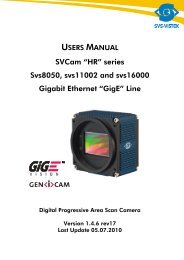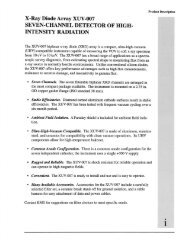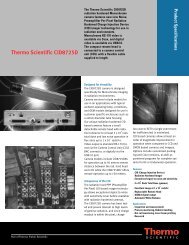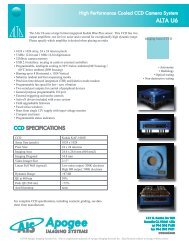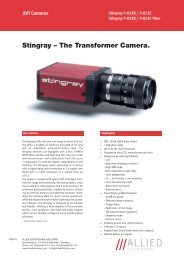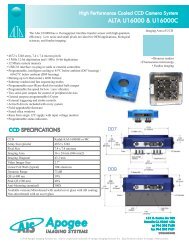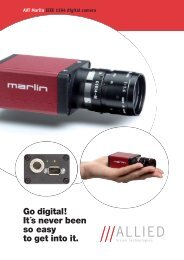KAF-1603E/ME (PDF) - Quantum Scientific Imaging
KAF-1603E/ME (PDF) - Quantum Scientific Imaging
KAF-1603E/ME (PDF) - Quantum Scientific Imaging
Create successful ePaper yourself
Turn your PDF publications into a flip-book with our unique Google optimized e-Paper software.
<strong>KAF</strong>-1603 IMAGE SENSOR1536 (H) X 1024 (V) FULL FRA<strong>ME</strong> CCD IMAGE SENSORJULY 27, 2012DEVICE PERFORMANCE SPECIFICATIONREVISION 1.0 PS-0036
<strong>KAF</strong>-1603 Image SensorTABLE OF CONTENTSSummary Specification ......................................................................................................................................................................................... 4Description .................................................................................................................................................................................................... 4Features ......................................................................................................................................................................................................... 4Application .................................................................................................................................................................................................... 4Ordering Information ............................................................................................................................................................................................ 5Device Description ................................................................................................................................................................................................. 6Architecture .................................................................................................................................................................................................. 6Dark Reference Pixels ............................................................................................................................................................................ 7Output Structure ..................................................................................................................................................................................... 7Dummy Pixels ........................................................................................................................................................................................... 7Image Acquisition ........................................................................................................................................................................................ 7Charge Transport ......................................................................................................................................................................................... 7Horizontal Register ..................................................................................................................................................................................... 8Output Structure ..................................................................................................................................................................................... 8Physical Description .................................................................................................................................................................................... 9Pin Description and Device Orientation ............................................................................................................................................ 9<strong>Imaging</strong> Performance .......................................................................................................................................................................................... 10Typical Operational Conditions............................................................................................................................................................. 10Specifications............................................................................................................................................................................................. 10Typical Performance Curves ............................................................................................................................................................................ 11Defect Definitions ................................................................................................................................................................................................ 12Operating Conditions .............................................................................................................................................................................. 12Specifications............................................................................................................................................................................................. 12Operation .................................................................................................................................................................................................................. 13Absolute Maximum Ratings ................................................................................................................................................................... 13DC Bias Operating Conditions ............................................................................................................................................................... 14AC Operating Conditions ........................................................................................................................................................................ 14Clock Levels ........................................................................................................................................................................................... 14Timing ......................................................................................................................................................................................................................... 15Requirements and Characteristics ....................................................................................................................................................... 15Frame Timing ............................................................................................................................................................................................. 16Line Timing (each Output) ...................................................................................................................................................................... 16Storage and Handling .......................................................................................................................................................................................... 17Storage Conditions................................................................................................................................................................................... 17ESD ............................................................................................................................................................................................................... 17Cover Glass Care and Cleanliness ......................................................................................................................................................... 17Environmental Exposure ........................................................................................................................................................................ 17Soldering Recommendations ................................................................................................................................................................ 17Mechanical Information ..................................................................................................................................................................................... 18Completed Assembly ............................................................................................................................................................................... 18Quality Assurance and Reliability .................................................................................................................................................................. 20Quality and Reliability ............................................................................................................................................................................. 20Replacement .............................................................................................................................................................................................. 20Liability of the Supplier ........................................................................................................................................................................... 20Liability of the Customer ........................................................................................................................................................................ 20Test Data Retention ................................................................................................................................................................................. 20Mechanical .................................................................................................................................................................................................. 20www.truesenseimaging.com Revision 1.0 PS-0036 Pg 2
<strong>KAF</strong>-1603 Image SensorDevice DescriptionARCHITECTURE4 Dark lines V1<strong>KAF</strong> - 1603Usable Active Image Area1536(H) x 1024(V)9 x 9 µm pixels V2Guard3:2 aspect ratioVrd RVddVoutVssSub4 Dark10 Inactive1536 Active Pixels/Line12 Dark2 Inactive4 Dark lines H1 H2VogFigure 1: Block DiagramThe sensor consists of 1552 parallel (vertical) CCD shift registers each 1032 elements long. These registers act as boththe photosensitive elements and as the transport circuits that allow the image to be sequentially read out of thesensor. The parallel (vertical) CCD registers transfer the image one line at a time into a single 1564 element(horizontal) CCD shift register. The horizontal register transfers the charge to a single output amplifier. The outputamplifier is a two-stage source follower that converts the photo-generated charge to a voltage for each pixel.Micro lensV1 electrodeV2 electrodeSiliconFigure 2: Microlens Cross-SectionMicro lenses are formed along each row. They are effectively half of a cylinder centered on the transparent gates,extending continuously in the row direction. They act to direct the photons away from the polysilicon gate and throughthe transparent gate. This increases the response, especially at the shorter wavelengths (< 600 nm).www.truesenseimaging.com Revision 1.0 PS-0036 Pg 6
<strong>KAF</strong>-1603 Image SensorDark Reference PixelsThere are 4 light shielded pixels at the beginning of each line, and 12 at the end. There are 4 dark lines at the start ofevery frame and 4 dark lines at the end of each frame. Under normal circumstances, these pixels do not respond tolight. However, dark reference pixels in close proximity to an active pixel can scavenge signal depending on lightintensity and wavelength and therefore will not represent the true dark signal.Output StructureCharge presented to the floating diffusion is converted into a voltage and current amplified in order to drive off-chiploads. The resulting voltage change seen at the output is linearly related to the amount of charge placed on thefloating diffusion. Once the signal has been sampled by the system electronics, the reset gate (φR) is clocked toremove the signal, and the floating diffusion is reset to the potential applied by Vrd (see Figure 3). More signal at thefloating diffusion reduces the voltage seen at the output pin. In order to activate the output structure, an off-chip loadmust be added to the Vout pin of the device such as shown in Figure 4.Dummy PixelsWithin the horizontal shift register are 10 leading additional pixels that are not associated with a column of pixelswithin the vertical register. These pixels contain only horizontal shift register dark current signal and do not respondto light. A few leading dummy pixels may scavenge false signal depending on operating conditions. There are twomore dummy pixels at the end of each lineIMAGE ACQUISITIONAn electronic representation of an image is formed when incident photons falling on the sensor plane create electronholepairs within the sensor. These photon-induced electrons are collected locally by the formation of potential wellsat each photogate or pixel site. The number of electrons collected is linearly dependent on light level and exposuretime and non-linearly dependent on wavelength. When the pixel's capacity is reached, excess electrons will leak intothe adjacent pixels within the same column. This is termed blooming. During the integration period, the φV1 and φV2register clocks are held at a constant (low) level, and the sensor is illuminated. See Figure 8. The sensor must beilluminated only during the integration period. Light must not reach the sensor during the time the image is read out.This is usually accomplished with the use of a mechanical shutter or a pulsed light source.CHARGE TRANSPORTReferring to Figure 9, the integrated charge from each photogate is transported to the output using a two-stepprocess. During this readout time, the sensor needs to be protected from all light through the use of a shutter orpulsed light source. Each line (row) of charge is first moved from the vertical CCD to the horizontal CCD register usingthe φV1 and φV2 register clocks. The horizontal CCD is presented a new line on the falling edge of φV2 while φH1 isheld high. The horizontal CCD then transports each line, pixel by pixel, to the output structure by alternately clockingthe φH1 and φH2 pins in a complementary fashion. On each falling edge of φH2 a new charge packet is transferredonto a floating diffusion and sensed by the output amplifier.www.truesenseimaging.com Revision 1.0 PS-0036 Pg 7
<strong>KAF</strong>-1603 Image SensorHORIZONTAL REGISTEROutput StructureH1H2H1H2HCCDChargeTransferVDDVogRVrdFloatingDiffusionVoutSourceFollower#1Figure 3: Output SchematicSourceFollower#2Vout~5ma+15V0.1uF2N3904 or equivalentBuffered Output140 1k Figure 4: Output Structure Load Diagramwww.truesenseimaging.com Revision 1.0 PS-0036 Pg 8
<strong>KAF</strong>-1603 Image Sensor<strong>Imaging</strong> PerformanceTYPICAL OPERATIONAL CONDITIONSAll values measured at 25 °C, and nominal operating conditions. These parameters exclude defective pixels.SPECIFICATIONSDescription Symbol Min. Nom. Max Units NotesSaturation SignalVertical CCD capacityHorizontal CCD capacityOutput Node capacity<strong>Quantum</strong> Efficiency (microlens)<strong>Quantum</strong> Efficiency (no microlens)Nsat85000170000190000100000200000220000 24000077%65%VerificationPlanelectrons/pixel 1 design 9%QE design 9Photoresponse Non-Linearity PRNL 1.0 2.0 % 2 design 9Photoresponse Non-Uniformity PRNU 0.8 % 3 die 8Dark SignalJdark1025010electrons/pixel/secpA/cm 2 4 die8Dark Signal Doubling Temperature 6.3 7 °C design 9Dark Signal Non-Uniformity DSNU 10 50 electrons/pixel/sec 5 die 8Dynamic Range DR 72 74 DB 6 design 9Charge Transfer Efficiency CTE 0.99997 0.99999 die 8Output Amplifier DC Offset Vodc Vrd Vrd + 0.5 Vrd + 1.0 V die 8Output Amplifier Sensitivity Vout/Ne - 9 10 µV/e - design 9Output Amplifier Output Impedance Zout 180 200 220 Ohms design 9Noise Floor ne - 15 20 electrons 7 die 8Notes:1. For pixel binning applications, electron capacity up to 330000 can be achieved with modified CCD inputs. Each sensor mayhave to be optimized individually for these applications. Some performance parameters may be compromised to achievethe largest signals.2. Worst-case deviation from straight line fit, between 2% and 90% of Vsat.3. One Sigma deviation of a 128 x 128 sample when CCD illuminated uniformly at half of saturation.4. Average of all pixels with no illumination at 25 °C5. Average dark signal of any of 11 x 8 blocks within the sensor (each block is 128 x 128 pixels).6. 20log (Nsat / ne - ) at nominal operating frequency and 25 °C.7. Noise floor is specified at the nominal pixel frequency and excludes any dark or pattern noises. It is dominated by theoutput amplifier power spectrum with a bandwidth = 5 * pixel rate.8. A parameter that is measured on every sensor during production testing.9. A parameter that is quantified during the design verification activity.www.truesenseimaging.com Revision 1.0 PS-0036 Pg 10
Absolute <strong>Quantum</strong> Efficiency<strong>KAF</strong>-1603 Image SensorTypical Performance Curves<strong>KAF</strong>-1603 Spectral Response10.90.80.70.60.50.40.30.20.10400 500 600 700 800 900 1000with microlens Wavelength (nm) without microlensFigure 6: Typical Spectral Responsewww.truesenseimaging.com Revision 1.0 PS-0036 Pg 11
<strong>KAF</strong>-1603 Image SensorDefect DefinitionsOPERATING CONDITIONSAll tests performed at T = 25 °CSPECIFICATIONSClassification Point Defect Cluster Defect Column DefectTotal Zone A Total Zone A Total Zone AC2 10 5 4 2 0 01,10241536,1024368,8121168,812Zone ACenter 800 x 600 Pixels368,212 1168,2121,1 1536,1Figure 7: Active Pixel RegionPoint Defects Dark: A pixel that deviates by more than 6% from neighboring pixels when illuminated to 70%of saturation.-- OR --Bright: A pixel with a dark current greater than 5000 e - /pixel/sec at 25 °C.Cluster DefectColumn DefectA grouping of not more than 5 adjacent point defects.A grouping of more than 5 contiguous point defects along a single column.A column containing a pixel with dark current greater than 12,000 e - /pixel/sec (bright column).A column that does not meet the minimum vertical CCD charge capacity (low charge capacitycolumn).A column which loses more than 250 e - under 2 ke - illumination (trap defect).Neighboring PixelsDefect SeparationThe surrounding 128 x 128 pixels or 64 column/rows.Column and cluster defects are separated by no less than two (2) pixels in any direction(excluding single pixel defects).www.truesenseimaging.com Revision 1.0 PS-0036 Pg 12
<strong>KAF</strong>-1603 Image SensorOperationABSOLUTE MAXIMUM RATINGSDescription Symbol Minimum Maximum Units NotesDiode Pin Voltages Vdiode 0 20 V 1, 2Gate Pin Voltages Vgate1 -16 16 V 1, 3, 6Output Bias Current Iout -10 mA 4Output Load Capacitance Cload 15 pF 4Storage Temperature T -20 80 °CHumidity RH 5 90 % 5Notes:1. Referenced to pin Vsub or between each pin in this group.2. Includes pins: Vrd, Vdd, Vss, Vout.3. Includes pins: φV1, φV2, φH1, φH2, Vog, Vlg, φR.4. Avoid shorting output pins to ground or any low impedance source during operation.5. T = 25 °C. Excessive humidity will degrade MTTF.6. This sensor contains gate protection circuits to provide some protection against ESD events. The circuits will turn on whengreater than 16 volts appears between any two gate pins. Permanent damage can result if excessive current is allowed toflow under these conditions.www.truesenseimaging.com Revision 1.0 PS-0036 Pg 13
<strong>KAF</strong>-1603 Image SensorDC BIAS OPERATING CONDITIONSDescription Symbol Minimum Nominal Maximum Units Maximum DC Current (mA) NotesReset Drain Vrd 10.5 11.0 11.5 V 0.01Output Amplifier Return Vss 1.5 2.0 2.5 V -0.5Output Amplifier Supply Vdd 14.5 15 15.5 V IoutSubstrate Vsub 0 0 0 V 0.01Output Gate Vog 3.75 4 5 V 0.01Guard Ring Vlg 8.0 9.0 12.0 V 0.01Video Output Current Iout -5 -10 mA - 1Note:1. An output load sink must be applied to Vout to activate output amplifier - see Figure 4.AC OPERATING CONDITIONSClock LevelsDescription Symbol Level Minimum Nominal Maximum Units Effective CapacitanceVertical CCD Clock - Phase 1 φV1 Low -10.5 -10.0 -9.5 V 6 nf (all φV1 pins)Vertical CCD Clock - Phase 1 φV1 High 0 0.5 1.0 V 6 nf (all φV1 pins)Vertical CCD Clock - Phase 2 φV2 Low -10.5 -10.0 -9.5 V 6 nf (all φV2 pins)Vertical CCD Clock - Phase 2 φV2 High 0.5 1.0 V 6 nf (all φV2 pins)Horizontal CCD Clock - Phase 1 φH1 Low -4.5 -4.0 -3.5 V 50 pFHorizontal CCD Clock - Phase 1 φH1 Amplitude 9.5 10.0 10.5 V 50 pFHorizontal CCD Clock - Phase 2 φH2 Low -4.5 -4.0 -3.5 V 50 pFHorizontal CCD Clock - Phase 2 φH2 Amplitude 9.5 10.0 10.5 V 50 pFReset Clock φR Low -3.0 -2.0 -1.75 V 50 pFReset Clock φR Amplitude 5.0 6.0 7.0 V 50 pFNotes:1. All pins draw less than 10 µA DC current.2. Capacitance values relative to VSUB.www.truesenseimaging.com Revision 1.0 PS-0036 Pg 14
<strong>KAF</strong>-1603 Image SensorTimingREQUIRE<strong>ME</strong>NTS AND CHARACTERISTICSDescription Symbol Minimum Nominal Maximum Units NotesφH1, φH2 Clock Frequency f H 4250 10 MHz 1, 2, 3Pixel Period (I count) t e 100 1 nsφH1, φH2 Setup Time t φHS 0.5 5 µsφV1, φV2 Clock Pulse Width t φV 4 20 µs 2Reset Clock Width t φR 10 420 ns 4Readout Time t readout 178 ms 5Integration Time t int 407 6Line Time t line 172.4 µs 7Notes:1. 50% duty cycle values.2. CTE may degrade above the nominal frequency.3. Rise and fall times (10/90% levels) should be limited to 5-10% of clock period. Cross-over of register clocks should bebetween 40-60% of amplitude.4. φR should be clocked continuously.5. t readout = (1032* t line ).6. Integration time is user specified. Longer integration times will degrade noise performance due to dark signal fixed patternand shot noise.7. t line = (3* t φV ) + t φHS + (1564* t e ) + t e .www.truesenseimaging.com Revision 1.0 PS-0036 Pg 15
<strong>KAF</strong>-1603 Image SensorFRA<strong>ME</strong> TIMINGFrame TimingtinttReadout1 Frame = 1032 LinesV1V2Line 1 2 1031 1032H1H2Figure 8: Frame TimingLINE TIMING (EACH OUTPUT)Line TimingDetailPixel TimingDetailtRV1tVRV2tVH1te1 countH1tHSteH2H2VpixR1564 countsVoutVsatVdarkVodcVsubFigure 9: Line TimingLine Content1-10 11-14 15 - 1550 1551-1562 1563-1564PhotoactivePixelsDark ReferencePixelsDummy PixelsVsatsignal VdarkVpixVodcVsubSaturated pixel video outputVideo output signal in no light situation,(Not zero due to Jdark and Hclock feedthrough)Pixel video output signal level, more electrons =less positive*Video level offset with respect to vsubAnalog Ground* See Image Aquisition section(page 4)Figure 10: Timing Diagramswww.truesenseimaging.com Revision 1.0 PS-0036 Pg 16
<strong>KAF</strong>-1603 Image SensorStorage and HandlingSTORAGE CONDITIONSDescription Symbol Minimum Maximum Units NotesStorageTemperatureOperatingTemperatureT ST -20 80 °C 1T OP -60 60 °CNotes:1. Storage toward the maximum temperature willaccelerate color filter degradation.ESD1. This device contains limited protection againstElectrostatic Discharge (ESD). ESD events maycause irreparable damage to a CCD image sensoreither immediately or well after the ESD eventoccurred. Failure to protect the sensor fromelectrostatic discharge may affect deviceperformance and reliability.2. Devices should be handled in accordance withstrict ESD procedures for Class 0 (
<strong>KAF</strong>-1603 Image SensorMechanical InformationCOMPLETED ASSEMBLYFigure 11: Completed Assembly (1 of 2)www.truesenseimaging.com Revision 1.0 PS-0036 Pg 18
<strong>KAF</strong>-1603 Image SensorFigure 12: Completed Assembly (2 of 2)www.truesenseimaging.com Revision 1.0 PS-0036 Pg 19
<strong>KAF</strong>-1603 Image SensorQuality Assurance and ReliabilityQUALITY AND RELIABILITYAll image sensors conform to the specifications stated in this document. This is accomplished through a combinationof statistical process control and visual inspection and electrical testing at key points of the manufacturing process,using industry standard methods. Information concerning the quality assurance and reliability testing procedures andresults are available from Truesense <strong>Imaging</strong> upon request. For further information refer to Application Note Qualityand Reliability.REPLACE<strong>ME</strong>NTAll devices are warranted against failure in accordance with the Terms of Sale. Devices that fail due to mechanical andelectrical damage caused by the customer will not be replaced.LIABILITY OF THE SUPPLIERA reject is defined as an image sensor that does not meet all of the specifications in this document upon receipt by thecustomer. Product liability is limited to the cost of the defective item, as defined in the Terms of Sale.LIABILITY OF THE CUSTO<strong>ME</strong>RDamage from mishandling (scratches or breakage), electrostatic discharge (ESD), or other electrical misuse of thedevice beyond the stated operating or storage limits, which occurred after receipt of the sensor by the customer, shallbe the responsibility of the customer.TEST DATA RETENTIONImage sensors shall have an identifying number traceable to a test data file. Test data shall be kept for a period of 2years after date of delivery.<strong>ME</strong>CHANICALThe device assembly drawing is provided as a reference.Truesense <strong>Imaging</strong> reserves the right to change any information contained herein without notice. All informationfurnished by Truesense <strong>Imaging</strong> is believed to be accurate.Life Support Applications PolicyTruesense <strong>Imaging</strong> image sensors are not authorized for and should not be used within Life Support Systems withoutthe specific written consent of Truesense <strong>Imaging</strong>, Inc.www.truesenseimaging.com Revision 1.0 PS-0036 Pg 20
<strong>KAF</strong>-1603 Image SensorRevision ChangesMTD/PS-0666Revision NumberDescription of Changes1.0 Initial Release.2.0 Remove Grade 3 device option (p9). Add cover glass configurations (p15). Update ESD (p10) and Cleanliness (p14) sections.3.0 Updated format. Removed part numbers.3.1 Correct table headings (p.14).3.2 Remove Class 1 parts from the defect specification table4.0 Removed part numbers 4H0342 and 4H0344PS-0036Revision Number1.0Description of Changes Initial release with new document number, updated branding and document template Updated Storage and Handling and Quality Assurance and Reliability sectionswww.truesenseimaging.com Revision 1.0 PS-0036 Pg 21©Truesense <strong>Imaging</strong> Inc., 2012. TRUESENSE is a registered trademark of Truesense <strong>Imaging</strong>, Inc.



